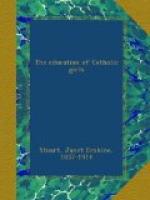In the last two or three years of a girl’s education all the time that can be spared may be most profitably spent on the study of modern history, since it is there that the more complex problems are found, and there also that they will understand how contemporary questions have their springs in the past, and see the rise of the forces which are at work now, disintegrating the nations of Europe and shaking the foundations of every government. There are grave lessons to be learnt, not in gloomy or threatening forecasts but in showing the direction of cause and effect and the renewal of the same struggle which has been from the beginning, in ever fresh phases. The outcome of historical teaching to Catholics can never be discouragement or depression, whatever the forecast. The past gives confidence, and, when the glories of bygone ages are weighed against their troubles, and the Church’s troubles now against her inward strength and her new horizons of hope, there is great reason for gratitude that we live in our own much-abused time. In every age the Church has, with her roots in the past, some buds and blossoms in the present and some fruit coming on for the future. Hailstorms may cut off both blossoms and fruit, but all will not be lost. We can always hold up our heads; there are buds on the fig-tree and we know in whom we have believed.
In bringing home to children these grounds for thankfulness, the quality of one’s own mind and views tells very strongly, and this leads to the consideration of what is chiefly required in teaching history to children, and to girls growing up. The first and most essential point is that we ourselves should care about what we teach, not that we should merely like history as a school subject, but that it should be real to us, that we should feel something about it, joy or triumph or indignation, things which are not found in text-books, and we should believe that it all matters very much to the children and to ourselves. Lessons of the text-book type, facts, dates, summaries, and synopses matter very little to children, but people are of great importance, and if they grasp what often they only half believe, that what they are repeating as a mere lesson really took place among people who saw and felt it as vividly as they would themselves, then their sympathies and understanding are carried beyond the bounds of their school-rooms and respond to the touch of the great doings and sufferings of the race.
It is above all in the history of the Church that this sympathetic understanding becomes real. The interest of olden times in secular history is more dramatic and picturesque than real to children; but in the history of the Church and especially of the personalities of the popes the continuity of her life is very keenly felt; the popes are all of to-day, they transcend the boundaries of their times because in a number of ways they did and had to do and bear the very same things that are done and have to be




